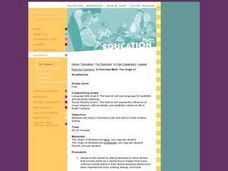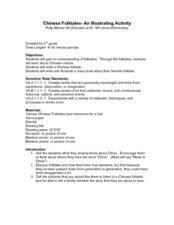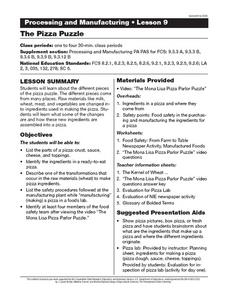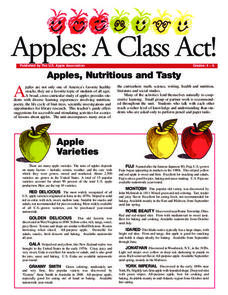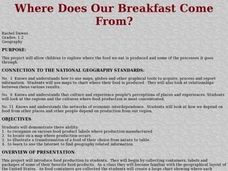Curated OER
Ecosystems
A critical look into the structure and function of ecosystems is here for young learners as a series of lessons and worksheet activities. Topics covered include land-based and marine ecosystems, connections to the water cycle, food webs,...
Look! We're Learning!
La Comida!
What would you like to eat? Perhaps una hamburguesa? Teach your class eight Spanish words that relate to food with these cards.
Curated OER
Cherokeee Myth: Origin of Strawberries
Fourth graders read a Cherokee myth about the origin of strawberries. After reading the story, they add another chapter to it and read their additions to the class. Or, as a group activity, they each write a few sentences and then pass...
Curated OER
SunPro After-Sun Treatment
In this vocabulary advancement worksheet, 5th graders read and interpret an original description of an after-sun cream product to find words that are related to ten key words listed for mastery. Students answer five true and false...
Curated OER
Building a Food Pyramid
Students review the concept of the food pyramid that has been taught by the classroom teacher. They have a classroom discussion of the food pyramid; understanding the importance of a healthy diet. Students create an original food pyramid.
American Museum of Natural History
Global Grocery
A walk through the grocery store is like a walk around the world. An interactive activity shows popular grocery items and where the ingredients originate. Perfect as a remote learning resource, the lesson connects groceries to the...
Curated OER
Chinese Folktales: An Illustrating Activity
In need of a really good lesson that incorporates literature, art, and cultural themes? After hearing a traditional Chinese folktale and discussing cultural themes and symbolism, learners create original illustrations for the story. This...
Curated OER
Are You What You Eat?
Learners observe what happens to the pigment of the Manduca when food coloring is added to their diet. They discuss how coloration affects their lifestyle. They answer questions to complete the lesson.
Curated OER
Plant Science Introduction
A unique PowerPoint explains the basics of plant science. It motivates viewers to study plant science and then lists different food products, biofuels, fibers, timber, and ornamental uses of plants. It concludes with lists of careers...
Curated OER
The Pizza Puzzle
Students identify the origin and preparation of the main ingredients in pizza. They identify the food safety procedures followed in a pizza factory and then prepare and eat a pizza in class.
Mascil Project
Molecular Gastronomy - Science in the Kitchen
Some say cooking is an art—and a science! Scholars scope out the savory subject of molecular gastronomy with a series of related activities. The teacher's guide contains printable worksheets and helpful tips for implementing the...
US Apple Association
Apples: A Class Act! (Grades 4–6)
Middle schoolers have a bushel of fun as they engage in activities and research core facts about apples. Packed with suggestions for in-class activities and out-of-class research, the colorful 6-page packet is sure to satisfy hungry...
Curated OER
Comparing the Food Choices and Body Image of 15-Year-Olds Around the World
Students interpret data regarding food choices and the perceived body image of youth in the world. In this personal health lesson, students compare food consumption patterns in Canada with other countries. Students also compare lifestyle...
Curated OER
Food and Languages of the World
Students explore and notice how foods from different countries of the world are alike and different. In this food and languages of the world lesson, students examine fruit and bread from a variety of countries around the world. After...
Curated OER
Farm Products Help Me Grow
Students view a display of empty food containers (or illustrations). They select a food and decide as a class if it has an animal or plant origin. Students view a display of common farm animals that are commonly eaten (cow, pig, chicken,...
Curated OER
Where Does Our Breakfast Come From?
Students bring in the cartons and containers of some of their favorite foods. They locate the origin of these foods on a map and visit a farm to view how food is grown and processed by a farmer. Students read books, complete worksheets...
Curated OER
It's All in the Spice
Students explore different spices that come from all over the world. Students discover names of certain spices they might not have been aware of. Students learn where certain spices originated and they discuss what the world would be...
Curated OER
Plants 'R' Us!
Students investigate the interdependencies of plants and animals, and study what a food web is. They create a food web using yarn and images.
Curated OER
Eat Your Plants
Students explore fruits and vegetables. In this fruits and vegetables lesson plan, students work in small groups investigating plant parts. Students discover that fruits and vegetables originate from different parts of plants.
Curated OER
Forest Ecology
Students examine the different plants and animals in British Columbia. In this forest ecology lesson students explore how ecosystems work, classify animals and investigate food webs and chains.
Curated OER
Grains, Fats, and Sugars in Healthy Proportions - Skill
Students investigate dietary guidelines and the food guide pyramid. They prepare various versions of pasta and muffins, and compare the taste, calories, fat, and cholesterol content.
Curated OER
Today is Monday Lesson Plan
Learners practice the days of the week. In this week lesson, students listen to the story "Today is Monday" and discuss what food matches with each day of the week. The learners put food cards out to match the story and draw these on a...
Curated OER
Social Studies: International Food Fair
Students identify activities that promote social studies education and enjoy an international food tasting session. On food item sheets, they write the origins of the various food items. On a laminated world map, each cook circles the...
Curated OER
Is Organic Food Worth the Extra Cost?
Young scholars calculate the amount of pesticide residue in selected foods for two
pesticides and determine if these levels are safe. They read an article about a
research study looking for metabolites of these pesticides in children....




